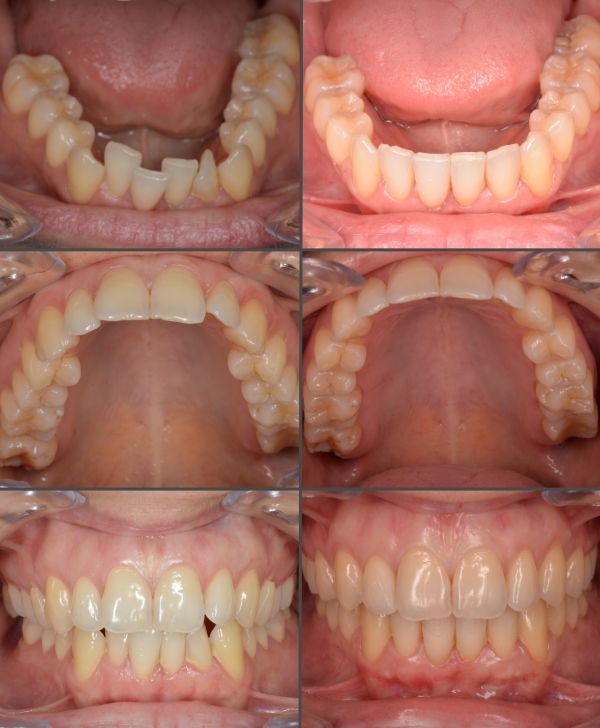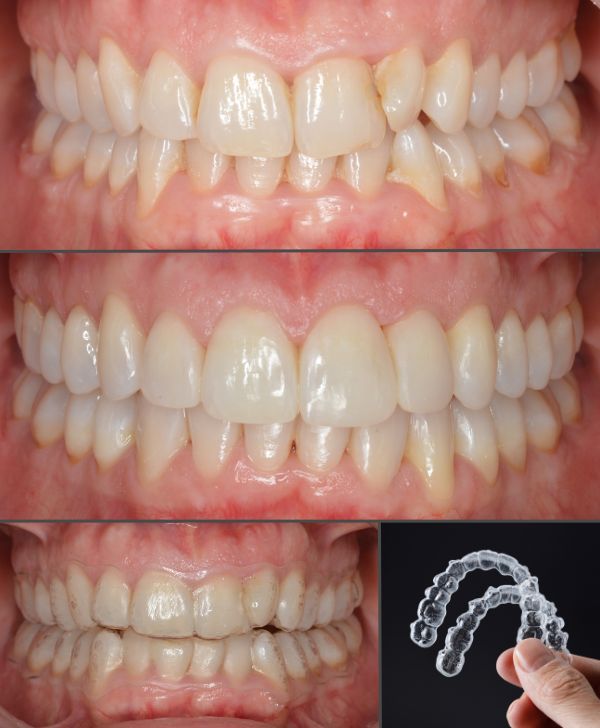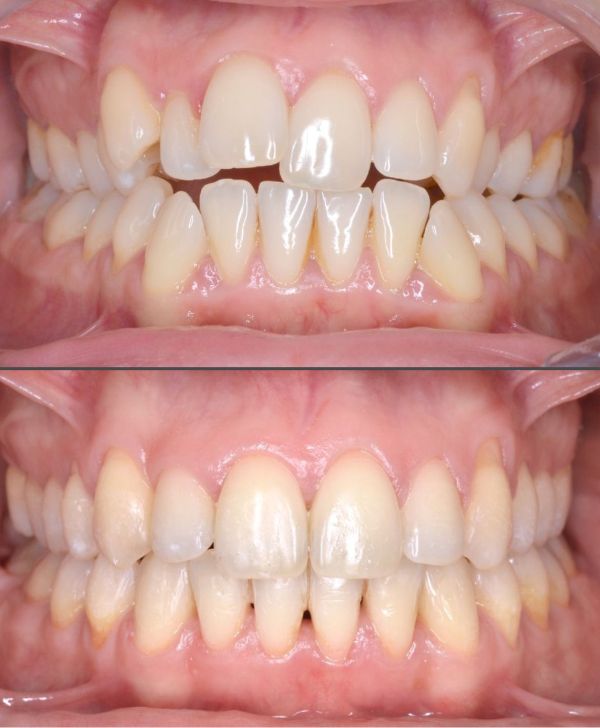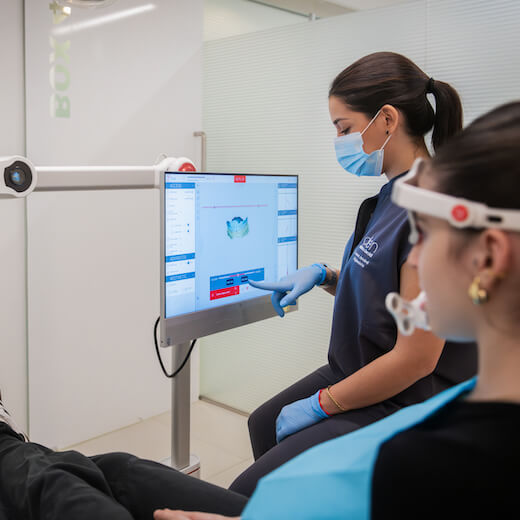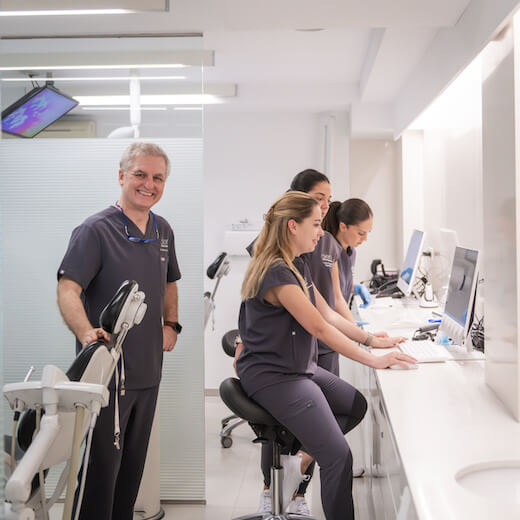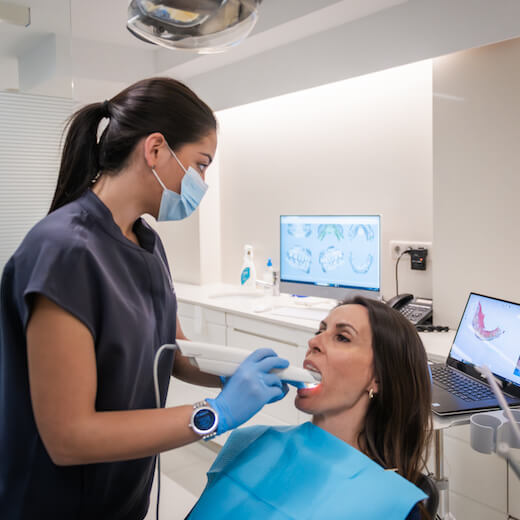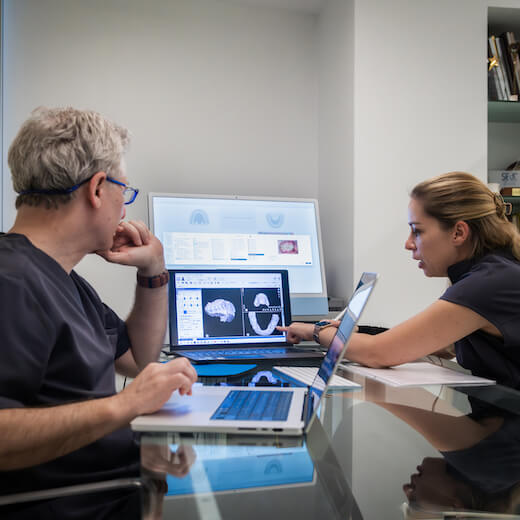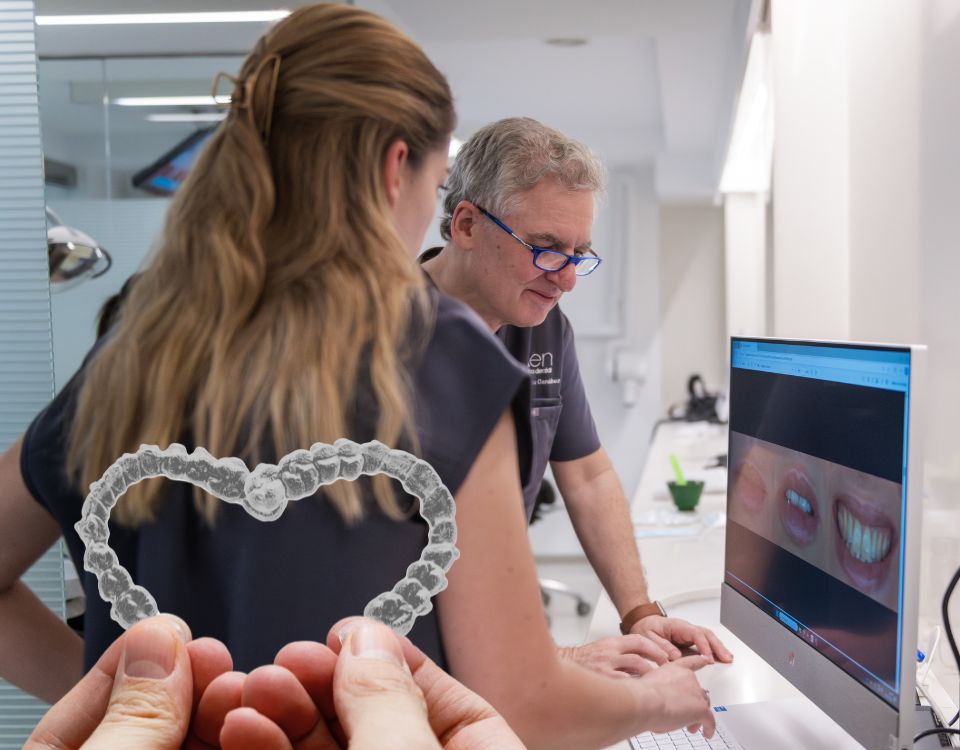
The most innovative invisible orthodontic treatment in Barcelona. It corrects the position of your teeth and stabilizes the function of your jawbone imperceptibly.
The transparent, removable aligners offer faster and more effective results in as little as 6 months.
Objectives of invisible orthodontics
Invisible orthodontics is an innovative treatment that uses transparent and removable sleeves, better known as invisible aligners, to correct the position of the teeth to achieve an optimal structure for your mouth. Unlike braces, these clear aligners are much more aesthetic and adapt easily to almost any type of mouth and dental treatment.
In invisible orthodontics, the precision and quality of the materials are as important as the professional follow-up of the treatment. Therefore, to obtain the best quality results, it is essential that the process is supervised by dentists specialized in this type of case.
We are specialists in invisible orthodontic treatments in Barcelona
Dr. Alberto Canábez and the medical team at Clínicas Den have participated in the development of a new system whose aligners represent a before and after in the technology sector for invisible orthodontics.
4D Diagnosis and digital planning
We are pioneers in the use of ModJaw 4D in Barcelona, an advanced technology that records a patient’s mandibular movement in real time.
This tool enables dynamic functional analysis, essential for diagnosing occlusal disorders and planning treatments more accurately.
Thanks to this 4D system, we integrate aesthetic and functional information into a complete digital case plan. This allows us to correct your bite and align your teeth while respecting the individual biomechanics of your jaw, achieving more stable long-term results.
Multidisciplinary invisible orthodontics in Barcelona
We treat cases ranging from mild to the most complex with a multidisciplinary approach. DEN invisible aligners allow us to offer precise solutions tailored to each clinical need.

MINIMAL DEN
Simple and rapid results for patients with very mild crowding or slightly malpositioned teeth. Includes personalized diagnosis, 4D digital planning, and a treatment plan tailored to the patient’s specific goals.
“Ideal for specific goals”
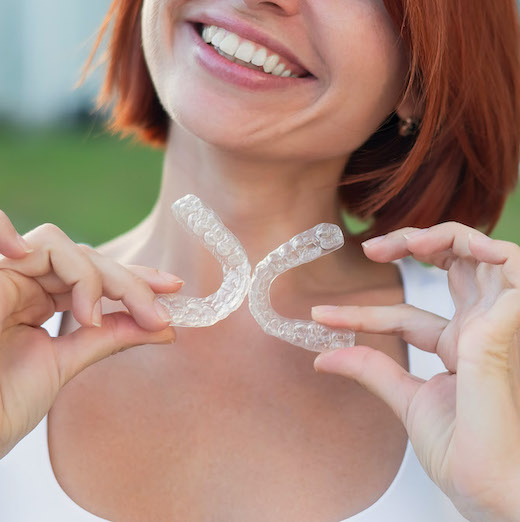
MODERATE DEN
Corrects dental crowding, diastemas, vertical shifts, and moderate expansions. Includes a complete diagnosis, 4D digital planning, and a treatment plan with invisible orthodontics tailored to the patient’s needs.
“Ideal for moderate corrections”
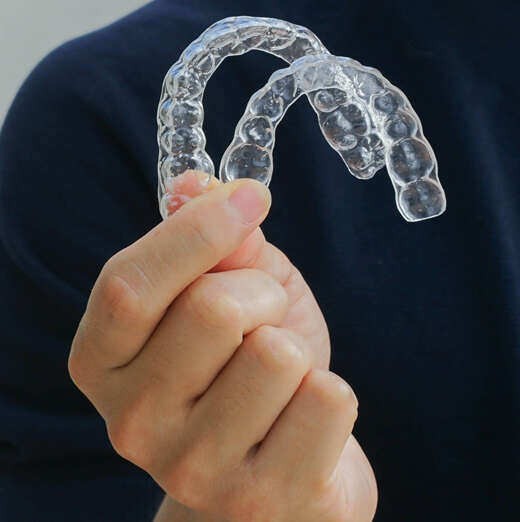
HYBRID DEN
Resolves functional bite disorders, malocclusions, TMJ problems, and advanced dental crowding. Includes a complete case diagnosis, 4D digital planning, and a personalized plan with aligners and occlusal rehabilitation techniques.
“Ideal for complex cases”
The best dental team in Barcelona

Our orthodontics department is led by Dr. Alberto Canábez, a professor of FACE courses nationally and internationally, with more than 30 years of experience in highly complex dental treatments.
“You want a beautiful smile, and we want you to never lose it. That’s why, in addition to caring for your aesthetics, we correct the functionality of your jaw.”
The doctors at our clinic are trained in the FACE therapeutic excellence protocols, the most demanding and advanced on the market.
What is FACE?
FACE (Functional and Cosmetics Excellence) is a group of orthodontists from the Americas, Asia, and Europe recognized worldwide for the quality of their results. At Clínicas Den, as part of FACE, we place the utmost importance on aesthetics, proper masticatory function, and long-term results.

Testimonials from our patients
Frequently asked questions about invisible orthodontics
Is this type of treatment painful?
This treatment is usually painless, although it’s normal to feel slight pressure or discomfort for the first few days after changing aligners. This sensation indicates that your teeth are moving correctly.
Thanks to its digital design, each movement can be planned with greater precision, applying gentle, controlled forces that protect the gums and improve the patient experience.
How many hours a day do I have to wear the aligners?
As much time as possible. It is recommended that you wear them for a minimum of 22 hours a day, this means that you should only take them off to eat and brush your teeth.
How long does invisible orthodontic treatment last?
The duration of treatment with state-of-the-art aligners always varies depending on the clinical case, but for most patients it ranges between 6 and 24 months.
The duration depends on the type of condition to be treated, the degree of correction your smile needs, and the combination with other dental treatments.
Depending on the complexity of the case:
- Mild: approximately 6 to 8 months (specific goals).
- Medium: approximately 8 to 16 months (moderate corrections).
- Advanced: approximately 12 to 24 months (complex cases).
However, as it is a highly precise, digitalized system, invisible orthodontics allows for shorter treatment times compared to more traditional techniques such as braces.
Furthermore, at Clínicas Den, we plan each phase of treatment with advanced technology (3D and 4D) so that you can achieve visible results in less time and with complete comfort.
Note: We’ll explain the type and duration of treatment to you during a specific appointment, where we’ll discuss your specific case with you.
Can I drink all kinds of liquids?
It’s best to only drink water while wearing your aligners. For other beverages (such as coffee, tea, wine, beer, soda, or juice), it’s best to remove them to avoid possible staining or deformation of the aligners.
Will people notice that I wear braces?
Since they are invisible aligners—that is, completely transparent and removable—most people around you won’t even notice you’re wearing them.
Braces or invisible aligners, which is better?
Although both treatments correct tooth position, clear aligners currently represent a more comfortable, aesthetic, and personalized technological advance.
Their digital design allows for more precise planning of each movement, applying gentler forces than with braces. This helps maintain gum health and improves the patient’s experience during treatment.
They are removable, nearly invisible, and facilitate good oral hygiene, making them better suited to today’s busy lifestyles. They are also especially useful for patients with periodontal problems, as they allow for more careful monitoring throughout treatment.
On the other hand, traditional braces remain an effective option, especially in certain very complex cases. However, their visibility, reduced comfort, and difficulty maintaining good hygiene mean that many patients today prefer invisible aligners.
At Clínicas Den, Dr. Alberto Canábez‘s team assesses each case individually. Our goal is to always offer you the most effective, aesthetic, and respectful solution for your oral health.
What problems does invisible orthodontics correct?
Invisible aligners not only provide aesthetic and discreet support. They also address a wide variety of functional and structural problems with your teeth.
These are the most common cases they can correct:
Temporomandibular joint (TMJ) discomfort
Some bite misalignments can cause tension, noise, or pain in the joint. Invisible orthodontics helps improve dental position and bite balance, relieving pressure on the joint and promoting more natural function.
Tooth crowding
Lack of space in the arch, causing teeth to overlap, rotate, or become out of place. Aligners create space and gradually realign teeth.
Diastemas (gaps between teeth)
Visible spaces between teeth, especially the front teeth. Thanks to this treatment, they gradually close with smooth, controlled movements.
Overbite
When the upper teeth excessively cover the lower teeth. It can cause jaw wear and tension. Orthodontics corrects the relationship between the two arches.
Crossbite
This occurs when some upper teeth bite inside the lower teeth. This affects chewing and facial symmetry.
Open Bite
When the mouth is closed, the upper and lower teeth do not touch. This makes chewing and pronunciation difficult, and can affect aesthetics.
Dental Protrusion
Our front teeth (usually upper teeth) are excessively forward. Invisible aligners help return them to a more harmonious and functional position.
Reverse Bite (Class III)
The lower teeth are positioned in front of the upper teeth. This affects both chewing function and the aesthetics of the facial profile.
Dental Rotation (Rotated Teeth)
Some teeth, such as incisors or premolars, may be rotated on their axis. Invisible orthodontics repositions them precisely.
Midline deviation
When the center of the upper teeth does not match the center of the lower teeth. This affects facial symmetry, but can be corrected by aligning both arches.
Narrowing of the arches (arch collapse)
A very narrow dental arch can make alignment difficult. Aligners allow the arch to be slightly widened and improve the balance of the smile.
Minor fit problems when biting (occlusion)
Small misalignments when closing the mouth that can cause wear or discomfort. Aligners improve contact between teeth, promoting a more comfortable bite.
Relapse after previous orthodontic treatment
If teeth have shifted after wearing braces or aligners, this treatment allows for correcting their position without resorting to further visible methods.
How to put on and take off invisible aligners?
Learning how to insert and remove aligners correctly is key to making treatment more pleasant and effective.
Here’s a step-by-step guide to the simplest method:
To insert:
- Wash your hands with soap.
- Make sure your teeth are clean.
- Gently place the aligner over your teeth.
- Press gently with your fingers, first on your molars and then forward.
- Avoid biting down on them to insert them.
To remove:
- Wash your hands.
- Start at the back of your mouth, at your molars.
- Find the back edge of the tray.
- Use your fingertips to gently peel them off your teeth.
- First on one side and then the other, to prevent the aligner from breaking.
- Move forward and remove them slowly.
- Try not to remove them with force or hard objects.
Remember: always store them in their box and clean them thoroughly before reusing them. Proper handling will extend their lifespan and improve your treatment experience.
What are attachments and rubber bands used for in invisible orthodontics?
Although aligners are practically invisible, sometimes they need extra help to perform certain dental movements. This is where attachments and elastic bands come into play.
Attachments
- These are small, tooth-colored resin protrusions.
- They are placed on some teeth to improve the aligner’s grip.
- They allow for more complex movements, such as rotations or vertical shifts.
Elastic bands
- They are used in some cases to correct bite problems or malocclusions.
- They help better coordinate the movement and position of both arches.
- They are attached to the aligners with small plastic hooks or buttons.
Although not always necessary, both elements make treatment with invisible aligners more comprehensive and capable of correcting even very complex cases.
Tell us how we can help you
+34 932 18 80 80
Request information about Invisible orthodontics in Barcelona
By filling the next contact form, you can communicate with the professional team at our clinic and ask for more information about our treatments as well as book an appointment with our specialists.


